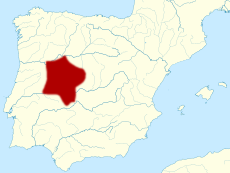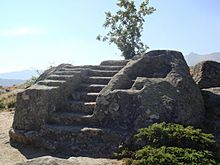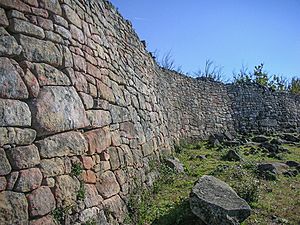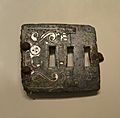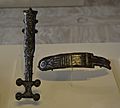Vettones facts for kids
The Vettones were an ancient group of people who lived in the Iberian Peninsula (modern-day Spain and Portugal) during the Iron Age. They were likely Celtic people.
Contents
Who Were the Vettones?
Experts like Lujan (2007) believe that some of the names used by the Vettones sound like old Celtic languages from western Spain. Some also think they might have been related to the Celtiberians, another group in ancient Iberia.
Around 300 BC, the Vettones started to organize themselves into a group of tribes. We don't know all their tribal names, but studies of old writings have found a few, like the Calontienses, Coerenses, Caluri, Bletonesii, and Seanoci.
How the Vettones Lived
The Vettones were mainly people who raised horses and cattle. They often moved their animals from one place to another depending on the season, a practice called transhumance.
Archaeologists have linked the Vettones to a culture from the Iron Age called 'Cogotas II'. This culture is also known as the 'Culture of the Verracos'. Verracos are large, rough stone sculptures of pigs, wild boars, and bulls. You can still see these sculptures in the areas where the Vettones once lived. They are one of the most famous things the Vettones left behind. Another possible legacy is the game of Calva, which is an old game that might have come from their time.
Archaeological sites and old burial grounds, such as Las Cogotas, La Osera, and El Raso de Candeleda, have shown us many things. They found weapons, shields, fancy pins called fibulae, belt buckles, bronze pots, and pottery from places like Campania and Greece. This tells us that the Vettones traded and had strong connections with other groups, including the Pellendones and people from the Mediterranean Sea.
Where the Vettones Lived
The Vettones lived in the western part of the meseta. This is a high, flat area in the middle of the Iberian peninsula. Today, this area includes parts of the Spanish provinces of Ávila, Salamanca, Zamora, Toledo, and Cáceres. They also lived in some eastern border areas of modern Portugal.
We don't know the name of their main capital city, as ancient writers didn't mention it. However, other towns they lived in have been found. These include Capara (now Ventas de Cápara), Obila (possibly Ávila), Mirobriga (possibly Ciudad Rodrigo), Turgalium (now Trujillo, Cáceres), and Alea (now Alía in Cáceres). Another likely Vettonian town was Bletisa or Bletisama (now Ledesma, Salamanca).
The History of the Vettones
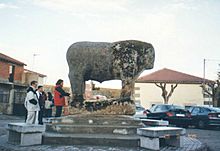
The Vettones were often friends with the Lusitani, another group of people. They helped the Lusitani fight against the Carthaginians, who were led by generals like Hasdrubal the Fair and Hannibal in the late 3rd century BC.
During the Second Punic War, the Vettones were at first under the control of Carthage. But after 206 BC, they broke free. However, some Vettones, led by a chief named Balarus, went with Hannibal to Italy as hired soldiers.
Later, in the Lusitanian Wars of the 2nd century BC, the Vettones again joined the Lusitani. They attacked areas like Baetica and Carpetania. They even tried to attack a town in North Africa called Ocilis (modern Asilah, Morocco) in 153 BC, but they didn't succeed.
Even though the Romans officially took control of the Vettones' land around 134-133 BC, the Vettones kept raiding the more Romanized areas to the south. During the Roman civil wars in the early 1st century BC, they supported a Roman general named Quintus Sertorius who was fighting against other Romans.
In 79 BC, a Roman leader named Quintus Caecilius Metellus Pius tried to secure the cities and tribes in central Hispania. He built forts in Vettonia, like Metellinum (Medellín) and Castra Caecilia (Cáceres el Viejo). But this didn't stop the Vettones from sending soldiers to help Sertorius' army in 77-76 BC.
The Vettones were defeated by Julius Caesar in 61 BC. Later, they supported Pompey, another Roman general, and fought in the battle of Munda near Montilla in Baetica.
Becoming Roman
In the 1st century BC, the Romans started building military settlements in Vettonia. These included Kaisarobriga (Talavera de la Reina) and Norba Caesarina (near Cáceres). Later came Metellinum (Medellín). Around 27-13 BC, the Vettones' land became part of a new Roman province called Lusitania, with its capital at Emerita Augusta (Mérida).
Even though they slowly became more like Romans, the Vettones kept their strong warrior traditions. This allowed them to provide a special cavalry (horseback soldier) unit to the Roman Army. This unit, called the Ala Hispanorum Vettonum Civium Romanorum, even helped Emperor Claudius when he invaded Britain in AD 43–60.
Not to Be Confused With
It's important not to mix up the Vettones with the Vettonenses, who were people living in a town called Vettona (today's Bettona) in Umbria, Italy. They were different groups.
Gallery
See also
 In Spanish: Vetones para niños
In Spanish: Vetones para niños
- Arevaci
- Bletonesii
- Carpetani
- Celtiberians
- Celtiberian script
- Cynetes
- Lusitanian Wars
- Sertorian Wars
- Roman civil wars
- Pre-Roman peoples of the Iberian Peninsula
- Ala Hispanorum Vettonum civium Romanorum


